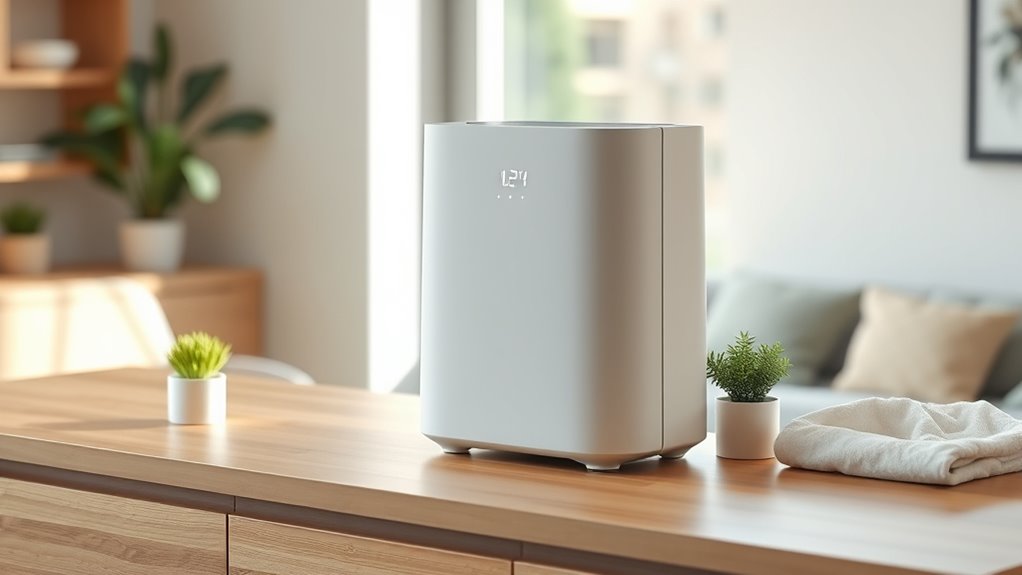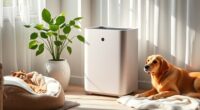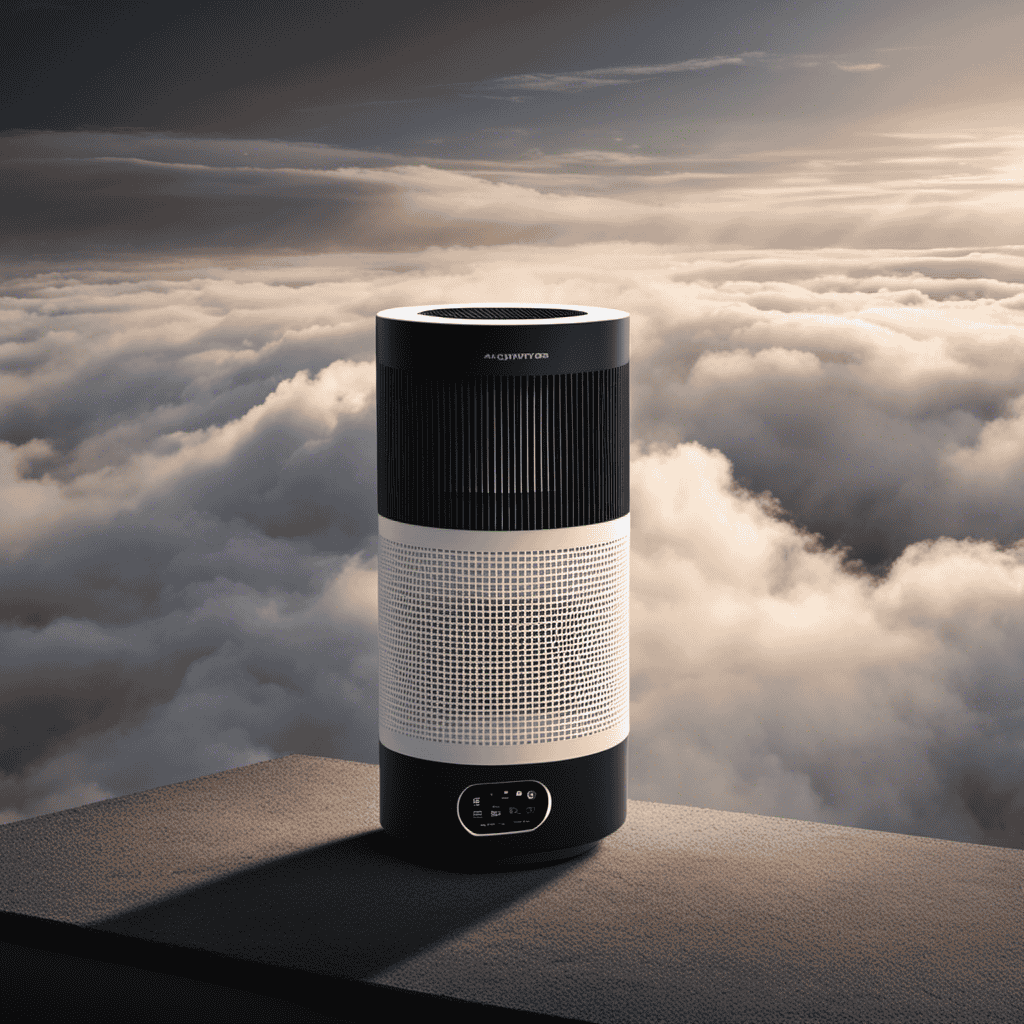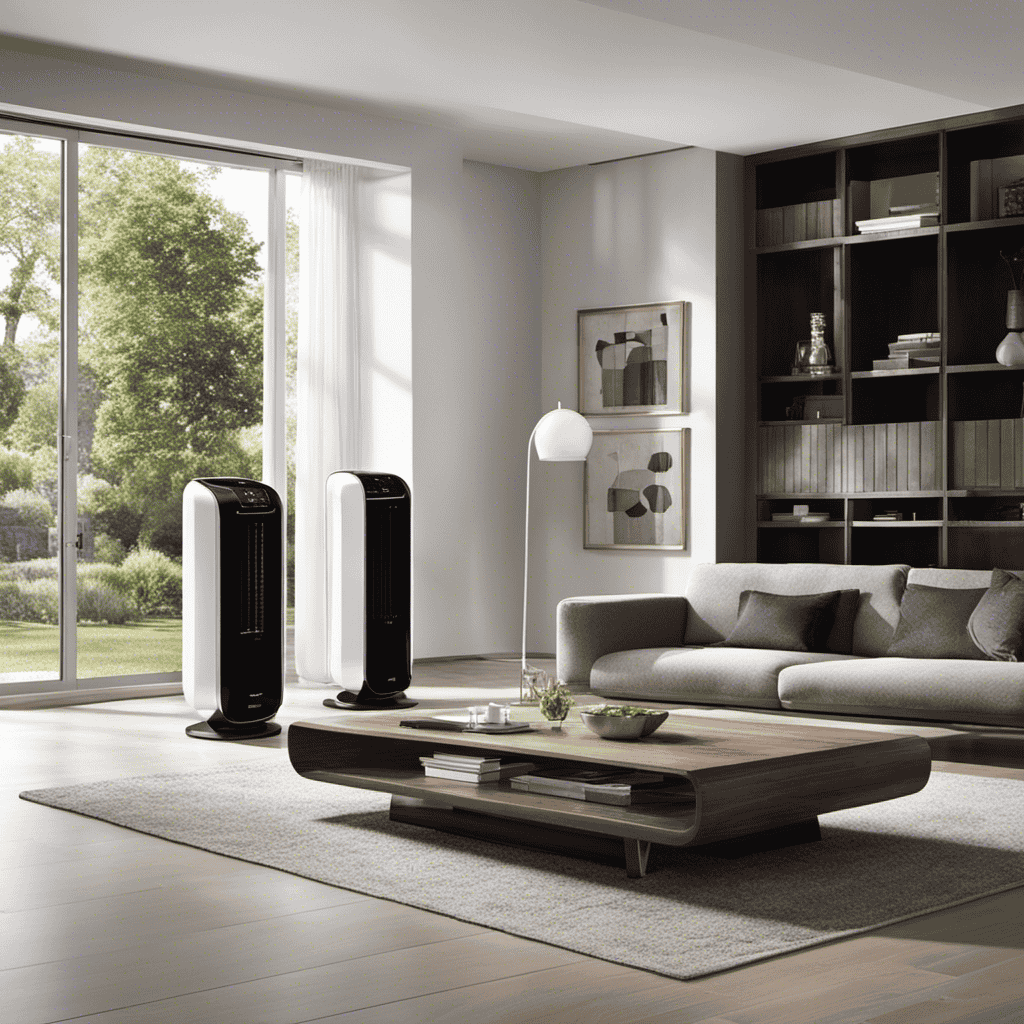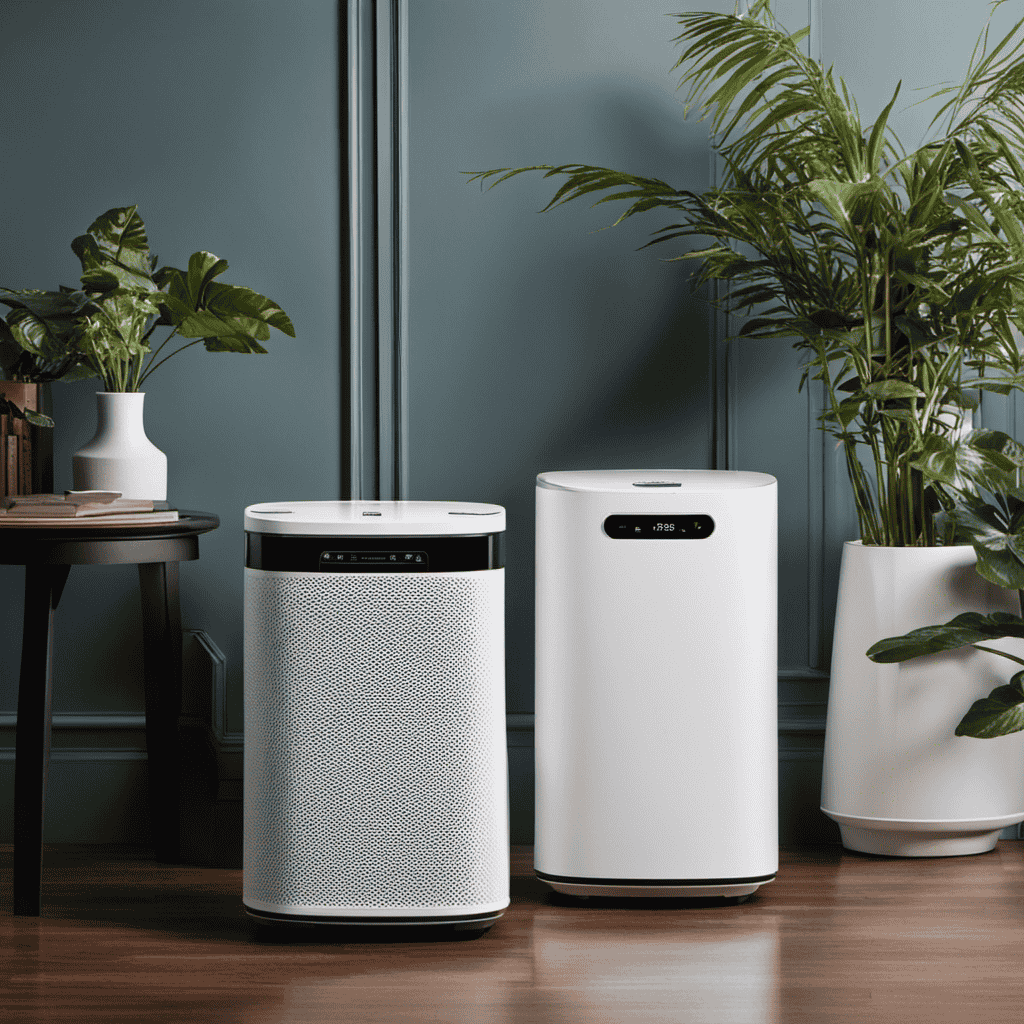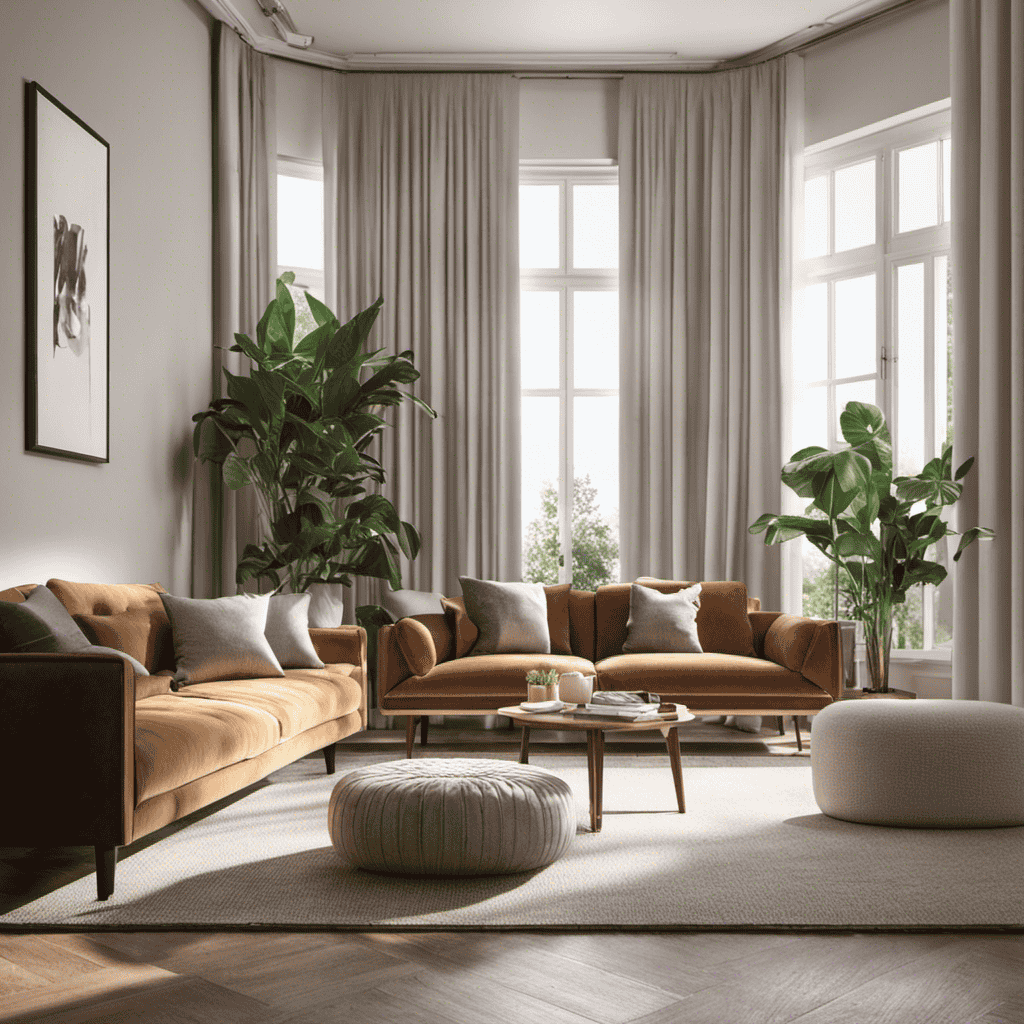Choosing the right air purifier starts with understanding how they work and identifying your main concerns, like allergies, odors, or germs. Consider the size of your space, the device’s CADR rating, energy use, and noise levels to find a model that fits your needs. Look for features like HEPA filters, activated carbon, and smart sensors for better performance. Staying within your budget and maintaining filters regularly helps guarantee long-term reliability—keep exploring to learn more.
Key Takeaways
- Determine your indoor air quality concerns to select the appropriate filter type and purifier size.
- Check CADR ratings and room size compatibility for efficient and effective air cleaning.
- Consider key features like energy efficiency, noise levels, and smart sensors for user convenience.
- Balance your budget with trusted brands and read reviews to ensure reliability and performance.
- Regular maintenance and filter replacement are essential for sustained air purifier effectiveness.
Understanding How Air Purifiers Work
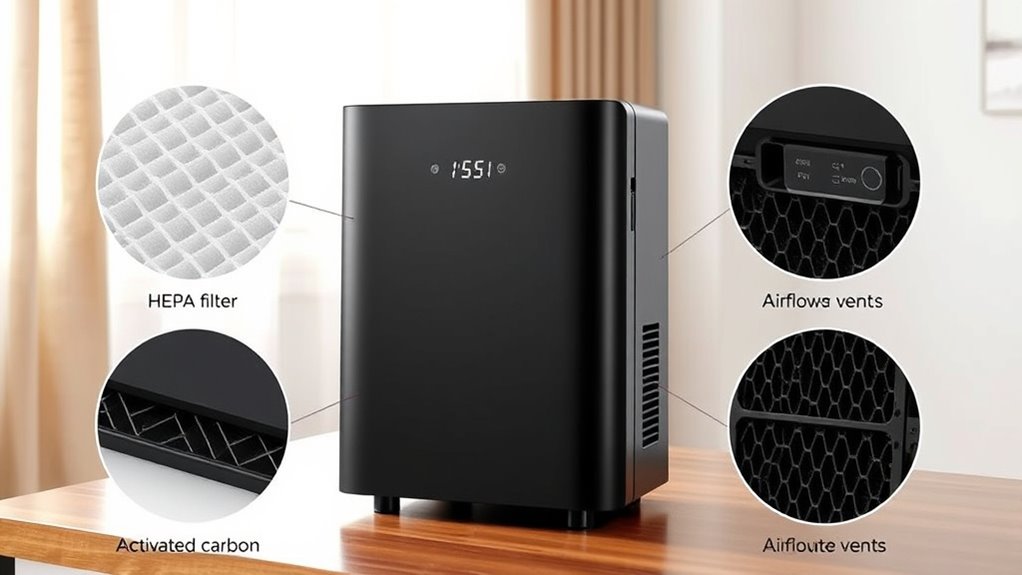
Understanding how air purifiers work is essential to choosing the right device for your needs. At their core, air purifiers use airflow dynamics to draw in contaminated air and pass it through filters that trap pollutants. The efficiency of this process depends heavily on filter materials, which vary from HEPA filters to activated carbon. HEPA filters capture particles like dust, pollen, and pet dander, while activated carbon adsorbs odors and gases. Proper airflow ensures pollutants are quickly pulled into the device and cleaned before circulating back into your space. Additionally, understanding airflow optimization techniques can help you select an air purifier that effectively addresses your specific air quality concerns, whether it’s allergens, odors, or airborne pollutants. Knowing how airflow interacts with different filter materials helps you choose a device that provides maximum filtration efficiency and reliability over time. Modern designs incorporate smart sensors to automatically adjust airflow and filtration levels based on real-time air quality data, further improving effectiveness. Implementing regular maintenance routines such as filter replacement ensures sustained performance and air purification efficiency. Moreover, the placement of the purifier within your space can significantly influence its effectiveness, emphasizing the importance of proper positioning.
Identifying Your Air Quality Concerns
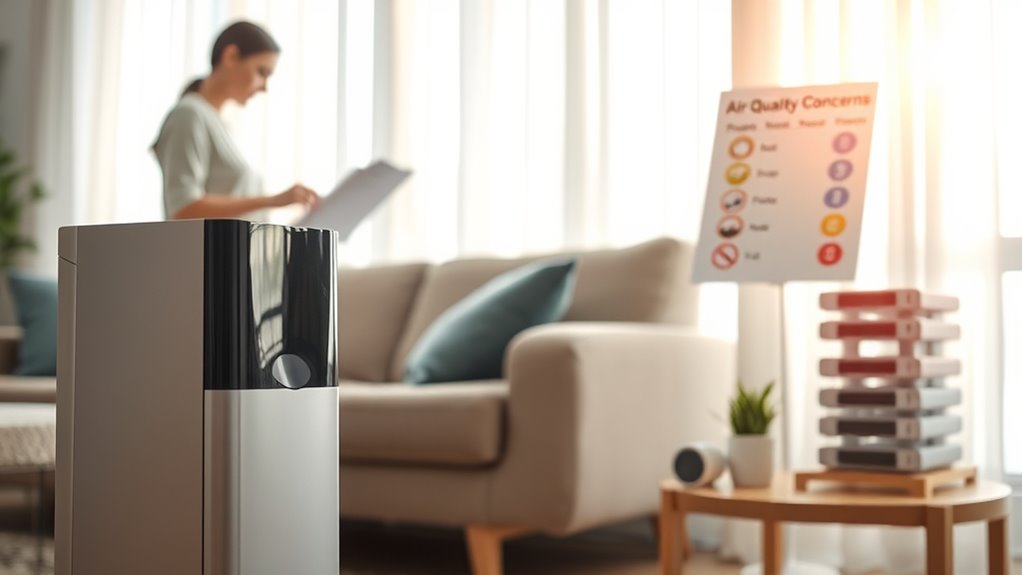
To choose the right air purifier, you need to clearly identify your specific air quality concerns. If indoor allergens like pollen, pet dander, or dust mites bother you, look for a purifier with a HEPA filter that captures tiny particles. For mold prevention, consider models with activated carbon filters or UV sterilization, which help eliminate mold spores and prevent mold growth. Think about where the air quality issues are most prominent—bedrooms, living rooms, or kitchens—and target those areas. Recognizing whether your main concern is allergy relief, mold, or general air cleanliness will guide you in selecting the most effective device. Additionally, understanding best air purifiers can help you make more informed choices tailored to your needs. Being aware of AI in media and entertainment is also beneficial, as emerging technologies can influence future air purifier features, such as smart integration and real-time air quality monitoring. Incorporating filter maintenance routines is crucial to ensure your air purifier continues to operate effectively over time. Regularly assessing your environment for new or evolving concerns will help you choose a device with multi-functionality that adapts to different needs. Considering air purifier effectiveness based on room size and filter type will further enhance your decision-making process. By understanding your specific needs, you can choose an air purifier that truly improves your indoor air environment.
Key Features to Consider in an Air Purifier
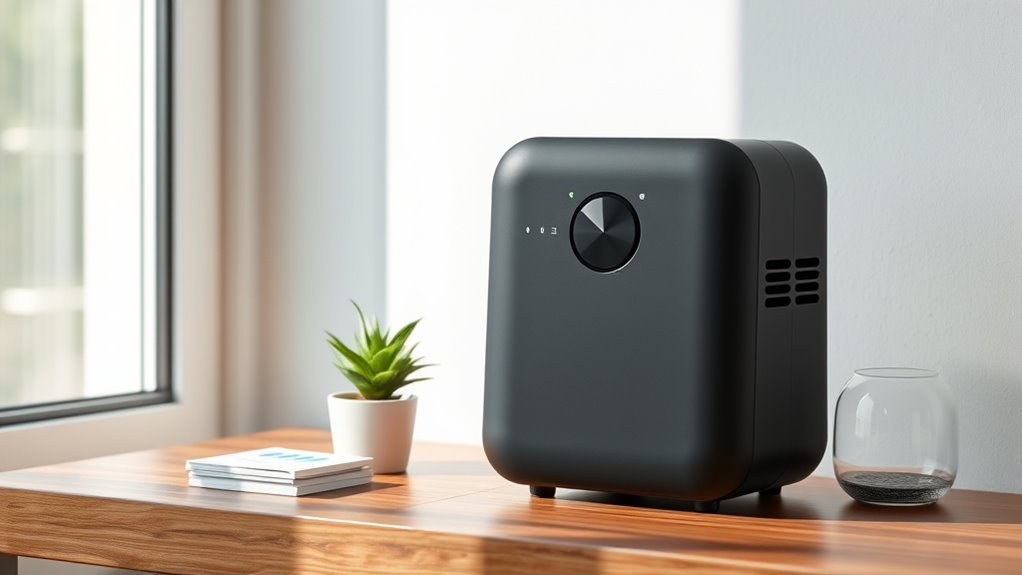
Choosing the right air purifier involves more than just identifying your main concerns; you also need to take into account its key features to guarantee it meets your needs. First, look for effective air quality monitoring to provide real-time data on indoor air conditions. This feature helps you understand pollutant levels and adjust settings accordingly. Next, consider the air purifier design—compact, sleek, and easy to place without cluttering your space. Third, check for adjustable fan speeds to control purification intensity. Additionally, some models include filter lifespan, which is crucial for scheduling maintenance and avoiding unexpected replacements. Understanding types of filters used can significantly impact your purifier’s effectiveness and maintenance needs. Incorporating models with auto functions can enhance performance by adjusting fan speeds based on real-time air quality readings. Moreover, evaluating filter replacement costs ensures ongoing maintenance remains manageable. Paying attention to filter material quality can also improve the longevity and efficiency of your air purifier, leading to better air quality over time. By focusing on these key aspects, you’ll select an air purifier that not only improves your indoor air but also integrates seamlessly into your environment.
Types of Air Purification Technologies
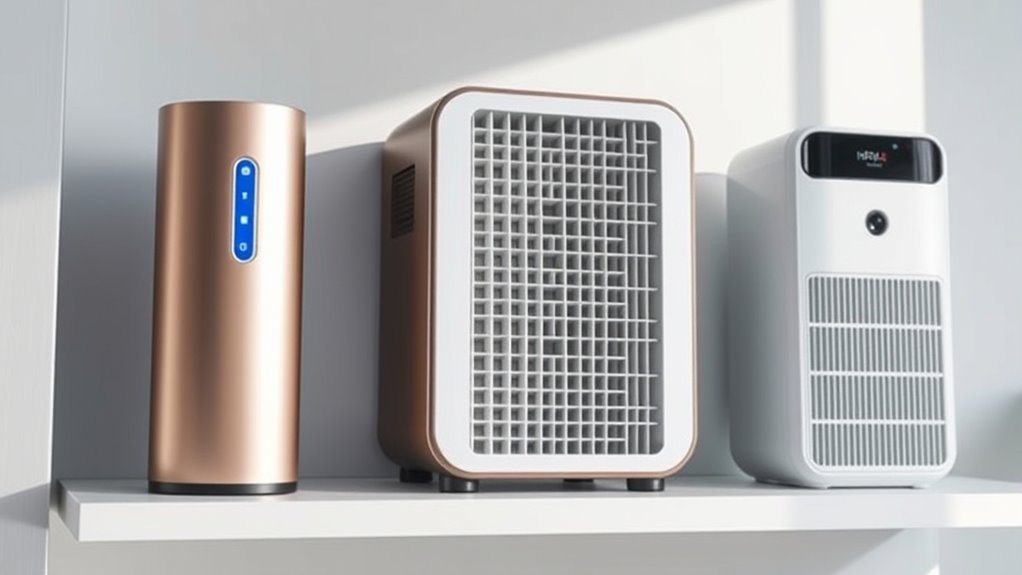
Understanding the different air purification technologies can help you choose the right device for your needs. HEPA filters efficiently trap tiny particles, while activated carbon absorbs odors and chemicals. UV light sterilization kills germs, adding an extra layer of protection. Additionally, some devices incorporate educational features that can help children understand air quality and safety. The integration of machine learning algorithms can further optimize air purification by adapting to changing indoor conditions and improving overall efficiency. Incorporating technological advancements can also enhance the device’s performance and user experience, especially when combined with personal growth principles that promote mindful and intentional use of technology. For example, modern air purifiers with automatic sensor detection can adjust their operation based on real-time air quality data to ensure optimal performance.
HEPA Filtration Efficiency
Have you ever wondered how HEPA filters effectively trap tiny airborne particles? Their success lies in strict filtration standards, ensuring high HEPA performance. HEPA filters must capture at least 99.97% of particles as small as 0.3 microns. To achieve this, consider these key points:
- Filtration efficiency: Meets or exceeds industry standards.
- Particle size: Capable of trapping allergens, pollen, and smoke.
- Filter lifespan: Regularly replaced to maintain performance.
- Testing standards: Certified by organizations like AHAM or ASTM.
- Vacuum filtration systems: High-quality vacuums with HEPA filters are tested for filtration efficiency to ensure they meet rigorous standards. Additionally, understanding airflow dynamics helps optimize the overall effectiveness of your air purification system. Recognizing filter quality is essential for selecting a reliable HEPA filter that maintains its performance over time. Regular maintenance and understanding filter replacement intervals further guarantee optimal results, especially in environments with high allergen levels. Paying attention to filter design can also contribute to better airflow and filtration performance.
Understanding these elements helps you pick an air purifier with reliable HEPA performance, ensuring cleaner air and healthier indoor environments. Remember, a high-quality HEPA filter is essential for effective air purification, especially in allergy-prone or polluted settings.
Activated Carbon Benefits
Activated carbon is a highly effective air purification technology that absorbs odors, chemicals, and volatile organic compounds (VOCs) from the air. Its key benefit lies in adsorptive filtration, where impurities stick to the surface of the carbon particles. This process helps eliminate common indoor pollutants like cooking smells, tobacco smoke, pet odors, and chemical fumes. Unlike other filters, activated carbon doesn’t just trap particles; it chemically bonds with pollutants, removing them from your environment. This makes it essential for improving air quality, especially in spaces with strong odors or chemicals. When combined with other filtration methods, activated carbon enhances overall efficiency. Its durability and capability to target a wide range of airborne toxins make it a valuable feature in many air purifiers for cleaner, healthier indoor air. Additionally, integrating activated carbon with vertical storage solutions can optimize space and maintain organized air purification systems. Proper maintenance and replacement of activated carbon filters are crucial to ensure continued effectiveness in air quality management.
UV Light Sterilization
UV light sterilization is a powerful air purification technology that uses ultraviolet light to inactivate bacteria, viruses, and mold spores. Its germicidal effects make it highly effective at reducing harmful microorganisms in the air. When considering UV sterilization, keep these key points in mind:
- It targets microorganisms at a cellular level, disrupting their DNA.
- UV light is most effective when directly exposed to the pathogens.
- Many air purifiers combine UV sterilization with HEPA filters for thorough cleaning.
- Regular maintenance ensures the UV light remains effective over time.
- Proper safety precautions should be followed to prevent UV exposure to skin and eyes. Incorporating home decor elements that promote a safe environment can help ensure safe placement and usage of UV sterilizers.
While UV sterilization doesn’t remove particles or odors, it considerably reduces airborne germs, making your environment safer and healthier. This technology is especially valuable in homes, offices, and healthcare settings.
Choosing the Right Size and Capacity
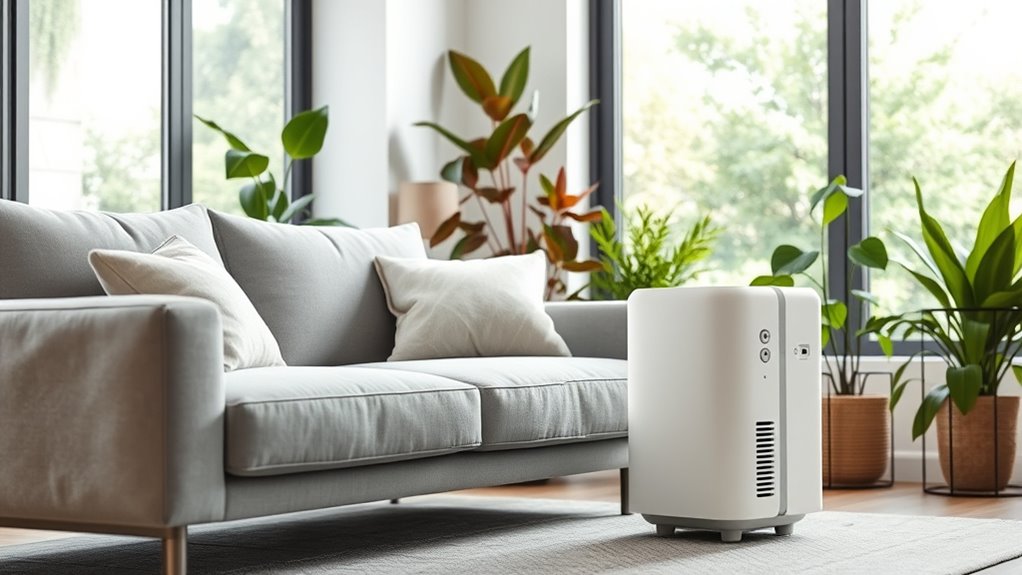
To select the appropriate air purifier, you need to take into account your room size in order to guarantee it can effectively clean the space. Pay attention to CADR ratings, which indicate how quickly an air purifier filters air in specific categories. Matching the device’s capacity with your room size guarantees ideal air quality and efficiency.
Room Size Compatibility
How do you guarantee your air purifier effectively cleans your space? The key is choosing the right size and capacity. First, measure your room’s square footage accurately. Second, check if the portable units have appropriate coverage; many include air quality sensors to optimize performance. Third, match the unit’s recommended room size with your space for maximum efficiency. Fourth, consider your needs—larger rooms may require more powerful models with higher CADR ratings. Remember, an air purifier that’s too small won’t clean thoroughly, while one that’s too large may waste energy. By focusing on these factors, you ensure your air quality sensors work effectively, and your air purifier delivers clean, fresh air for your specific space.
CADR Ratings Significance
Understanding CADR ratings is essential because they directly indicate how effectively an air purifier can remove pollutants from your space. Higher CADR ratings mean faster and more efficient smoke elimination, dust removal, and allergen reduction. When choosing an air purifier, look for a model with a CADR rating that matches your room size. This ensures the device can handle the air quality challenges you face without overworking or underperforming. For example, if smoke elimination is a priority, select an air purifier with a high CADR rating for smoke. This way, you’ll achieve better air purification results and create a healthier environment. Remember, the right size and capacity depend on your specific needs, so keep CADR ratings in mind during your selection process.
Evaluating Energy Efficiency and Noise Levels
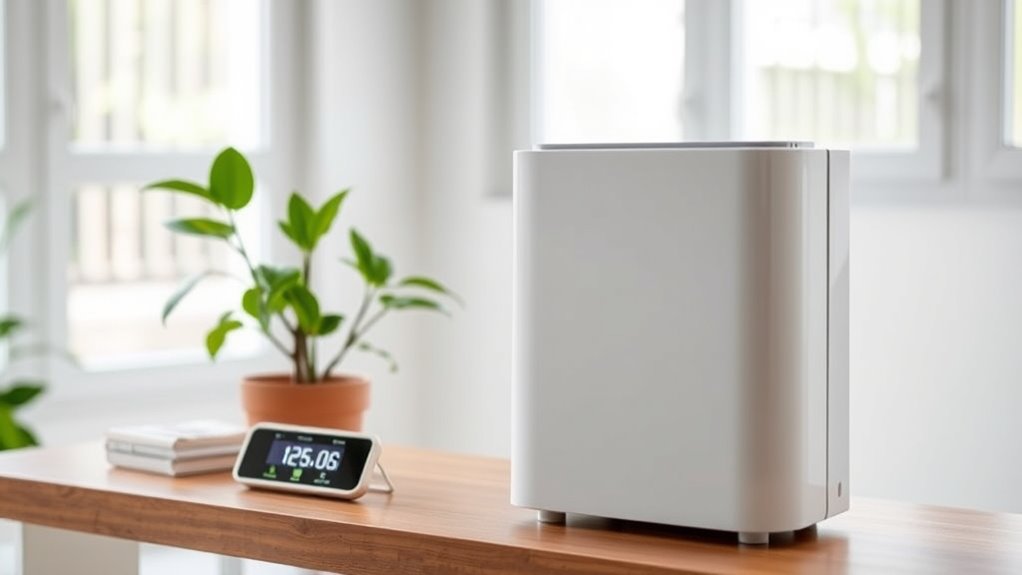
When choosing an air purifier, evaluating its energy efficiency and noise levels can save you money and ensure a comfortable environment. To do this effectively, consider the following:
- Check the device’s energy consumption—look for models with low wattage or ENERGY STAR certification.
- Review noise reduction features—aim for purifiers that operate quietly, especially if you plan to use them in bedrooms or offices.
- Observe the noise levels at different fan speeds—some purifiers are quieter on lower settings.
- Compare energy costs over time—more efficient units may have a higher upfront price but save you money long-term.
Prioritizing these factors helps you select an air purifier that’s both cost-effective and unobtrusive, enhancing your overall experience.
Budgeting and Finding the Best Value

Balancing your budget with the features you need is key to finding the best value in an air purifier. Look for budget-friendly options that offer essential functions without overspending. Focus on models that provide good filtration, energy efficiency, and quiet operation, as these features contribute to overall value for money. Don’t assume the most expensive model is always the best; sometimes, mid-range options deliver excellent performance at a lower cost. Read reviews and compare specifications to identify units that fit your financial plan while meeting your air quality needs. Remember, investing in a quality air purifier now can save you money long-term by reducing energy costs and avoiding frequent replacements. The goal is to find an option that balances affordability with effective performance.
Maintenance and Filter Replacement Tips
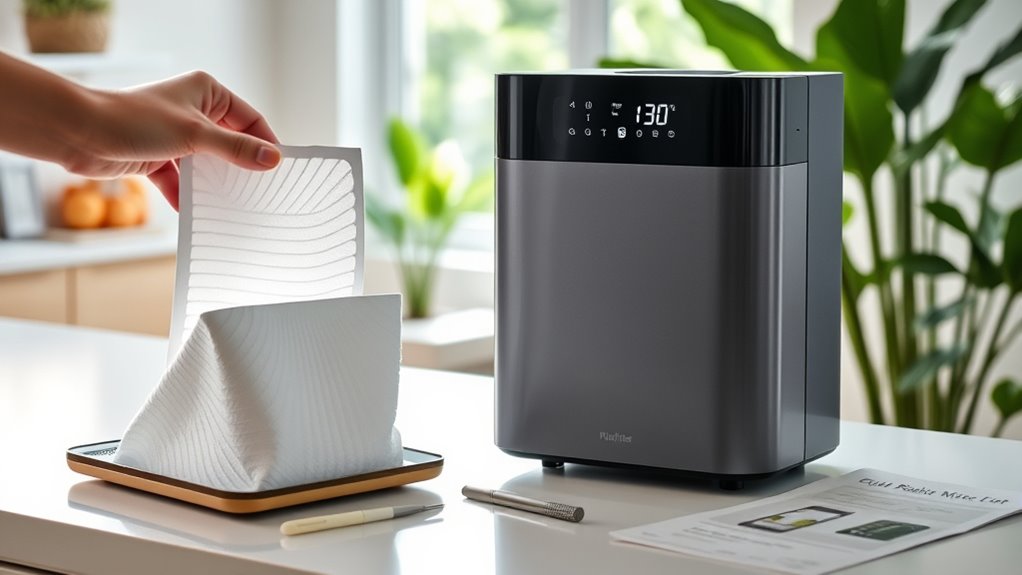
Maintaining your air purifier and replacing filters regularly guarantees it performs at its best and prolongs its lifespan. To optimize filter lifespan, follow a consistent maintenance schedule. Here are key tips:
- Check filters monthly to assess dirt buildup and plan replacements.
- Replace pre-filters every 3-6 months to prevent clogging.
- Change HEPA or carbon filters as recommended by the manufacturer, usually every 6-12 months.
- Clean the exterior and vents regularly to maintain airflow and prevent dust accumulation.
Sticking to this maintenance schedule helps ensure your purifier runs efficiently and maintains air quality. Remember, neglecting filter replacement can reduce effectiveness and increase energy consumption, so stay proactive. Proper upkeep maximizes your investment and keeps your environment healthier.
Where to Buy and What to Look for in Brands
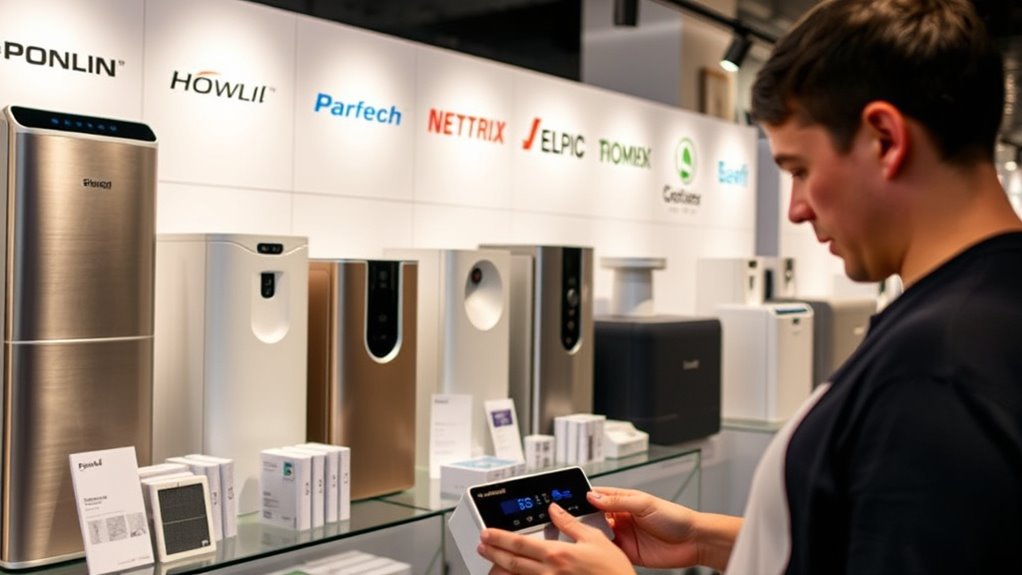
Finding the right place to buy your air purifier is crucial to guarantee you’re getting a quality product at a fair price. Start by checking reputable retailers, both online and in-store, that offer trusted brands with a solid reputation. Look for brands known for durability, effectiveness, and good customer support. Reading customer reviews helps you gauge real-world performance and identify any common issues. Prioritize brands with positive feedback and high ratings, as these indicate reliability. Avoid lesser-known brands without reviews or those with frequent complaints. When shopping, compare prices and warranty options to ensure you’re making a smart investment. By focusing on brand reputation and customer reviews, you’ll confidently choose a reliable air purifier that meets your needs.
Frequently Asked Questions
How Often Should I Replace My Air Purifier Filters?
You should replace your air purifier filters based on the filter lifespan and replacement schedule recommended by the manufacturer. Typically, filters need changing every 3 to 6 months, but this can vary depending on usage, air quality, and filter type. Keep an eye on signs like reduced airflow or odor, and check the device’s manual for specific guidance. Regular replacement guarantees peak performance and healthier air in your space.
Can Air Purifiers Remove Odors Effectively?
You might wonder if air purifiers can handle odors effectively. The answer is yes, they excel at odor elimination and air freshening. Equipped with activated carbon filters, they trap smells from cooking, pets, or smoke. Regular use guarantees fresher air, while proper maintenance boosts their efficiency. So, if you’re after a cleaner, more pleasant environment, an air purifier can be your best ally for odor control and air freshness.
Are HEPA Filters Safe for Children and Pets?
HEPA filters are safe for children and pets because they effectively trap airborne particles, including allergens and bacteria, without releasing harmful emissions. For child protection, choose air purifiers with certified HEPA filters, guaranteeing they meet safety standards. Always keep filters clean and replace them as recommended. This way, you can create a healthier environment, reduce allergens, and ensure your loved ones are protected from potential airborne hazards.
How Do I Know if an Air Purifier Is Truly Effective?
To know if an air purifier is truly effective, check its air quality indicators, which show real-time pollution levels. Look for models with good filter lifespan, ensuring they keep working efficiently over time. You should also review the CADR (Clean Air Delivery Rate) ratings to gauge how well it cleans the air in your space. A reputable purifier consistently reduces pollutants, so monitoring these factors helps confirm its effectiveness.
What Are the Signs That My Air Purifier Needs Maintenance?
Did you know that most air purifier filters last between 6 to 12 months? You’ll notice signs it needs maintenance when the filter lifespan is nearing its end, and indicator lights turn on. Reduced airflow, increased dust, or strange odors also signal it’s time for a check. Regularly replacing filters and paying attention to indicator lights maintains your purifier running efficiently and ensures you breathe clean air.
Conclusion
Remember, an air purifier is an investment in your health—so do your research and choose wisely. As the saying goes, “You get what you pay for,” but that doesn’t mean you have to overspend. By understanding your needs, weighing features, and maintaining your unit, you’ll breathe easier and enjoy a cleaner home. With patience and care, you’ll find the perfect fit and reap the benefits of fresher, healthier air every day.
